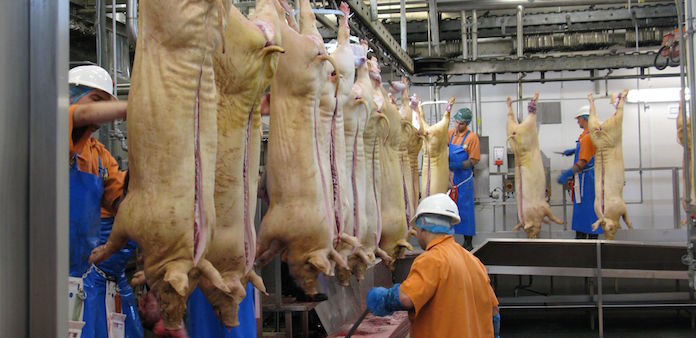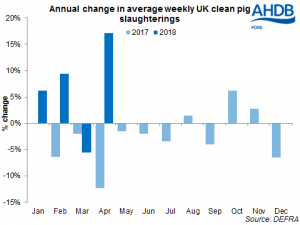The latest Defra statistics release includes downward revisions to official UK pig slaughtering numbers from November 2017 onwards.
Clean pig slaughterings during 2017 are now estimated at 10.38 million head, a 3% decline on the previous year. Meanwhile pig meat production stood at 897,700 tonnes, a 2% decline on 2016 levels.
For the first quarter of 2018, clean pig slaughterings now total 2.6 million head, 3% higher than year earlier levels. Production increased at the same rate, reaching 229,400 tonnes. The downwards revisions have implications for the pork production forecast, meaning the 2018 total is likely to be lower than previously anticipated.
Bethan Wilkins, an analyst at AHDB Pork, said: “Initial figures for April suggest UK pig supplies were perhaps surprisingly high during the month. Slaughterings were up 17% (+132,800 head) compared with a year earlier, reaching 908,300 head. Some of this increase will be attributable to the earlier Easter this year, meaning there were two extra working days in April 2018.
“However, even when taking this into account, April slaughterings per working day would still be over 5% higher than year earlier levels, according to the latest statistics release.”
The rise was particularly driven by slaughterings in Northern Ireland, which were reportedly up 31% (+40,000 head) on the previous year at 169,000 head. This level of increase is well above that recorded in the DAERA weekly figures, which suggest an annual growth closer to 10% for the month. As such, the increase may be somewhat overstated and subsequent revisions might be expected.
At 78,700 tonnes, the latest figures suggest UK pig meat production increased ahead of clean pig slaughterings during the month, growing 18% year-on-year. A rise in average carcase weights, to 83.8kg, supported production levels during the month. This was 900g above year earlier levels.
In addition, sow slaughterings were 4% higher than year earlier levels at 18,000 head. However, when taking the earlier Easter this year into account, and comparing on a per working day basis, like-for-like throughputs would actually be 7% lower.





